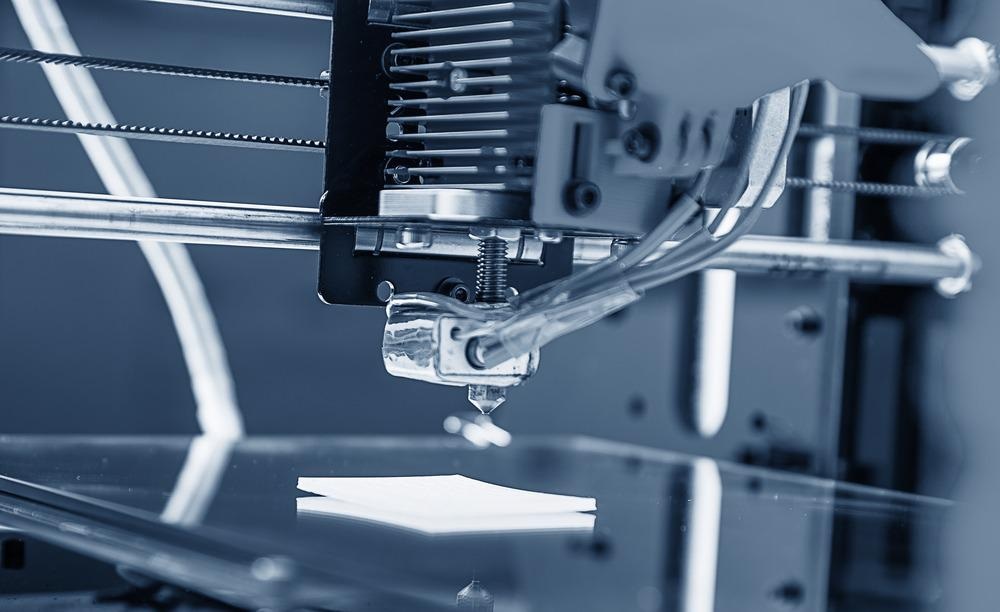 By Surbhi JainReviewed by Susha Cheriyedath, M.Sc.May 19 2022
By Surbhi JainReviewed by Susha Cheriyedath, M.Sc.May 19 2022In an article recently published in the journal Additive Manufacturing, researchers discussed the impact of dual curing and ionic liquids on the properties of 3D-printed ionogels as well as on the vat photopolymerization process.

Study: Effects of Ionic Liquids and Dual Curing on Vat Photopolymerization Process and Properties of 3D-printed Ionogels. Image Credit: Alex_Traksel/Shutterstock.com
Background
3D printing (3DP) is widely employed in major engineering areas to overcome the limits of traditional manufacturing processes in building complex structures, with a focus on soft robotic systems. The challenge is to design systems for performance and manufacturability while maintaining 3DP capability with diverse processing methods, such as those proposed for ionic liquids (IL).
Vat photopolymerization (VP), commonly known as stereolithography (SLA), has the best resolution of any additive technology, allowing for micron-scale details and superb surface smoothness.
Because of their propensity to be molten salt at low temperatures, the quantity of studies on ILs has increased dramatically. ILs have also been shown to speed up photopolymerization events in the VP during the formation of 3D structures. However, there is a paucity of research on the effect of ILs on photopolymerization rate during the VP and the effect of ILs on cure depth as measured by Jacobs working curves.
Nonetheless, achieving good resolution with photopolymer compositions containing a large proportion of an unreactive diluent, such as ILs, necessitates a thorough examination of the curing depth and VP.
About the Study
In this study, the authors discussed the immobilization of ILs via 3D printing and the polymerization of vinyl monomers in their medium. The impact of ILs on the VP process in the vat was investigated. EmimBF4, OmimBF4, BmimBF4, and EmimTFSI ionic liquids, as well as photocurable triethylene glycol dimethacrylate (TEGDMA) and N-vinylpyrrolidone (NVP) monomers, were used to create a number of IL-compatible photopolymer formulations.
The researchers presented the results of a study of photopolymer compositions containing various ionic liquids and monomers in order to establish a technology for high-resolution VP of IGs. The VP process was modified to ensure that enough monomers were converted in each 3D-printed layer to prevent interlayer cracking. In addition, a thermal initiator was added to the dual curing technique to get the best possible conversion (AIBN).
The team used photo-differential scanning calorimetry (DSC), FTIR, and charting of Jacobs working curves to investigate the photoinduced radical copolymerization of TEGDMA with NVP in the presence of ionic liquids.
The effects of IL concentration, type, post-cure regime, and monomer/crosslinker ratio on ionic conductivity, decomposition temperature, glass transition temperature, strength, tensile modulus, and elongation at the break of the 3D-printed IGs were investigated. Ultraviolet (UV) dual thermal curing was used for the first time in the 3D printing of IGs to maximize the conversion of the corresponding double bonds in the polymer.
Observations
TGA curves of cured V1T1 compositions with or without ILs showed no evidence of water or residual NVP. Under 120 °C, only V1T1Emim50 lost less than 1% of its weight. The thermal breakdown of the polymer caused significant weight loss between 300 and 400 °C.
When compared to V1T1 without IL, 30 wt% IL increased tensile strength in thermally post-cured species. At 30–40 wt% IL loading, the IGs produced by VP showed threshold percolation behavior. Due to IL crystallization in the polymer structure, the storage modulus of both UV and thermally post-cured V1T1Emim50 incremented fast from -32 to -20 °C.
The inclusion of ILs accelerated polymerization and increased the critical exposure energy due to a higher conversion degree required for gelation, which revealed a dichotomy of IL-based VP. Furthermore, Jacobs's working curves revealed that penetration depth varied substantially depending on IL type. Due to inhibition of IL mobility, dual curing boosted the mechanical characteristics of ionogels but decreased ionic conductivity. In addition, after photopolymerization and post-curing, the IL compositions for ionogels showed minimal shrinkage.
Dual curing with extra thermally triggered polymerization achieved around 100% conversion. As a result, thermostable IGs with acceptable mechanical characteristics and high ionic conductivity were produced and described.
Conclusions
In conclusion, this study elucidated the development of vat photopolymerized ionogels with the desired shape. The effects of the monomer/crosslinker ratio, as well as the presence of ionic liquids in the resin, were investigated. With the addition of ILs, the photopolymerization rate and maximum conversion increased.
However, due to the dilution of the fluid, the time required to accomplish gelation in photopolymer compositions (critical exposure time) increased. The peak maximum in the photo-DSC curve was used to calculate the over-curing time, whereas Jacobs working curves were used to determine the penetration depth. The usage of BmimBF4 and OmimBF4 in photopolymer compositions for VP resulted in no shrinkage during photopolymerization and post-curing.
The authors believe that the findings of this study could help in the development of a platform for generating high-resolution 3d-printed non-flammable and non-volatile ionogels.
More from AZoM: What are Profile Roughness Parameters?
Disclaimer: The views expressed here are those of the author expressed in their private capacity and do not necessarily represent the views of AZoM.com Limited T/A AZoNetwork the owner and operator of this website. This disclaimer forms part of the Terms and conditions of use of this website.
Source:
Nechausov, S., Ivanchenko, A., Morozov, O., et al. Effects of Ionic Liquids and Dual Curing on Vat Photopolymerization Process and Properties of 3D-printed Ionogels. Additive Manufacturing 102895 (2022). https://www.sciencedirect.com/science/article/abs/pii/S2214860422002937